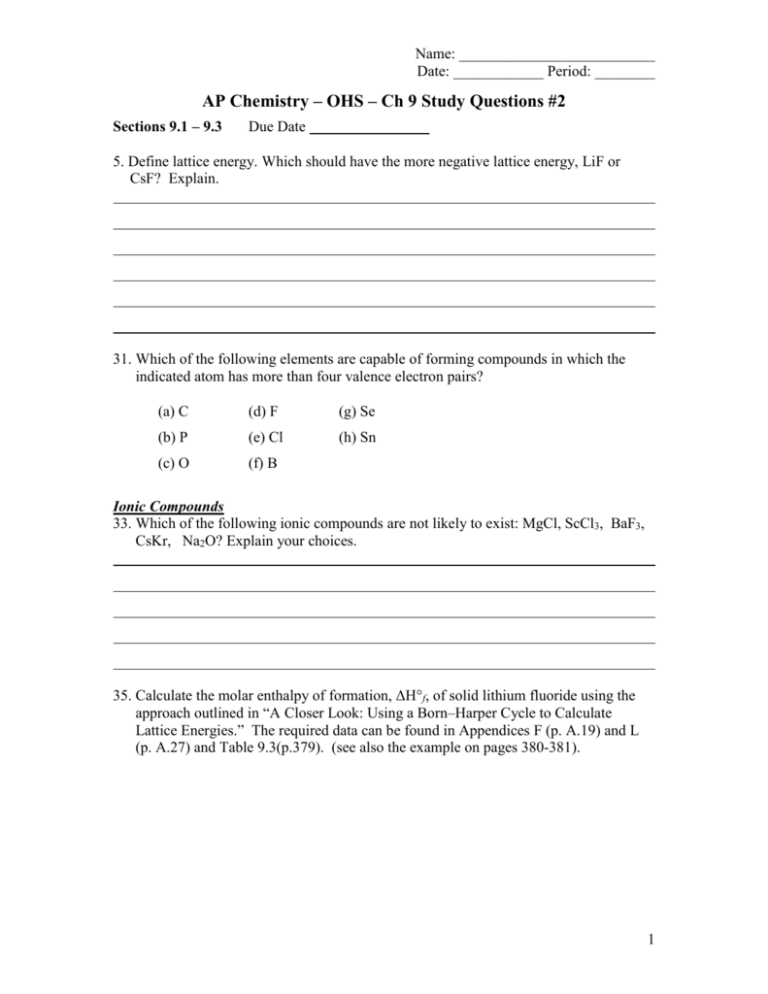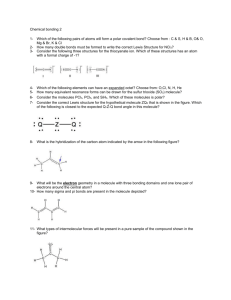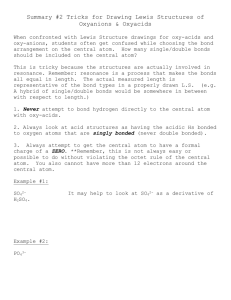Chapter 8 Study Questions #2
advertisement

Name: __________________________ Date: ____________ Period: ________ AP Chemistry – OHS – Ch 9 Study Questions #2 Sections 9.1 – 9.3 Due Date 5. Define lattice energy. Which should have the more negative lattice energy, LiF or CsF? Explain. 31. Which of the following elements are capable of forming compounds in which the indicated atom has more than four valence electron pairs? (a) C (d) F (g) Se (b) P (e) Cl (h) Sn (c) O (f) B Ionic Compounds 33. Which of the following ionic compounds are not likely to exist: MgCl, ScCl3, BaF3, CsKr, Na2O? Explain your choices. 35. Calculate the molar enthalpy of formation, ΔH°f, of solid lithium fluoride using the approach outlined in “A Closer Look: Using a Born–Harper Cycle to Calculate Lattice Energies.” The required data can be found in Appendices F (p. A.19) and L (p. A.27) and Table 9.3(p.379). (see also the example on pages 380-381). 1 Name: __________________________ Date: ____________ Period: ________ 37. Which compound in each of the following pairs should require the higher temperature to melt? (See Study Question 36 - pg. 372). a) NaCl or RbCl b) BaO or MgO c) NaCl or MgS Sections 9.4 – 9.6 Due Date 8. In boron compounds the B atom often is not surrounded by four valence electron pairs. Illustrate this with a Lewis Structure of. Show how the BCl3 molecule can achieve an octet configuration by forming a coordinate covalent bond with ammonia (NH3). Sections 9.7 – 9.8 15. Consider a series of molecules in which carbon is bonded by single bonds to atoms of second-period elements: C–O, C–F, C–N, C–C, and C–B. Place these bonds in order of increasing bond length. 17. What is the relationship among bond order, bond length, and bond energy for a series of related bonds, say carbon–nitrogen bonds? Bond Polarity and Electronegativity 51. For each of the following bonds, indicate the more polar atom and use an arrow to show the direction of polarity in each bond. (a) C – N (c) C – Br (b) C – H (d) S – O 2 Name: __________________________ Date: ____________ Period: ________ Bond Polarity and Formal Charge 55. Considering both formal charge and bond polarities, predict on which atom or atoms the positive charge resides in the following cations (you will need to draw the Lewis structures): (a) H3O+ (b) NH4+ (c) NO2+ (d) NF4+ 57. Compare the electron dot structures of the carbonate (CO32−) and borate (BO33−) ions. (a) Draw the Lewis structures. Are these ions isoelectronic? (b) How many resonance structures does each ion have? (c) What are the formal atom charges in each ion? (d) If an H+ ion attaches to CO32− to form the bicarbonate ion, HCO3−, does it attach to an O atom or to the C atom? 63. In each pair of bonds, circle which is shorter. (a) Si – N or Si – O (c) C – F or C – Br (b) The C–N bond or the C≡N bond in H2NCH2C ≡ N (d) Si – O or C – O 87. What are the orders of the N — O bonds in NO2− and NO2+? The nitrogen – oxygen bond length in one of these ions is 110 pm and in the other 124 pm. Which bond length corresponds to which ion? Explain briefly. 3 Name: __________________________ Date: ____________ Period: ________ Bond Energy 69. Phosgene, Cl2CO, is a highly toxic gas that was used as a weapon in WWI. Using the bond energies of Table 9.10(p. 422 in book), estimate the enthalpy change for the reaction of carbon monoxide and chlorine to produce phosgene. (Hint: First draw the electron dot structure of the reactants and products so you know the types of bonds involved.) CO(g) + Cl2(g) → Cl2CO(g) Molecular Geometry 73. Draw the Lewis structure for each of the following molecules or ions. Describe the electron-pair geometry and the molecular geometry. (a) ClF2+ (d) SiF62− (b) SnCl3− (e) PF5 (c) PO43− (f) XeF4 95. The cyanate ion, NCO−, has the least electronegative atom, C, in the center. The very unstable fulminate ion, CNO−, has the same formula, but the N atom is in the center. (a) Draw the three possible resonance structures of CNO−. (b) On the basis of formal charges, decide on the resonance structure for with the most reasonable distribution of charge. 4







